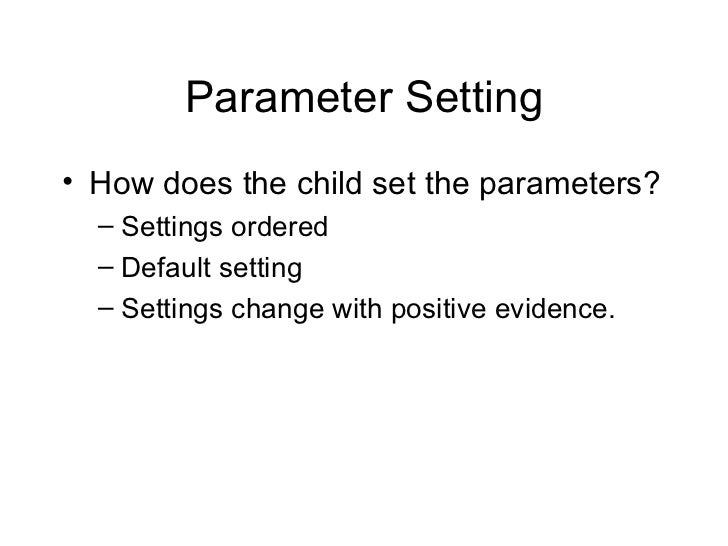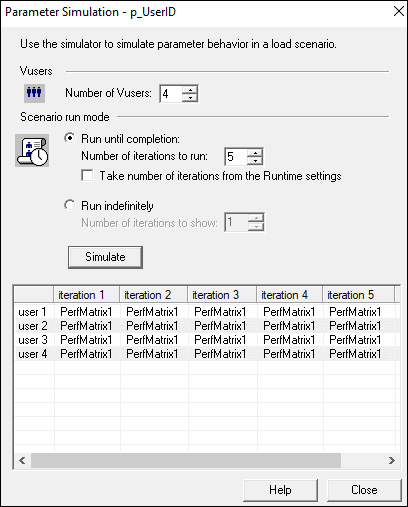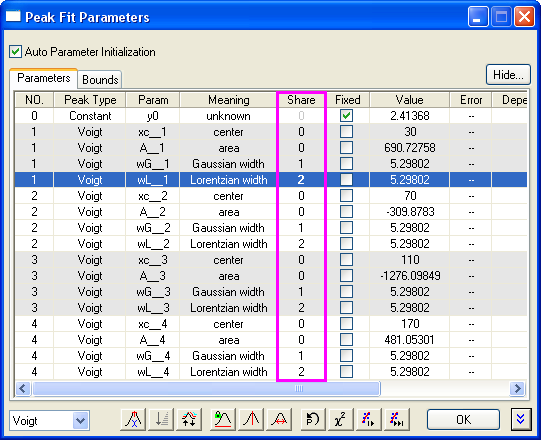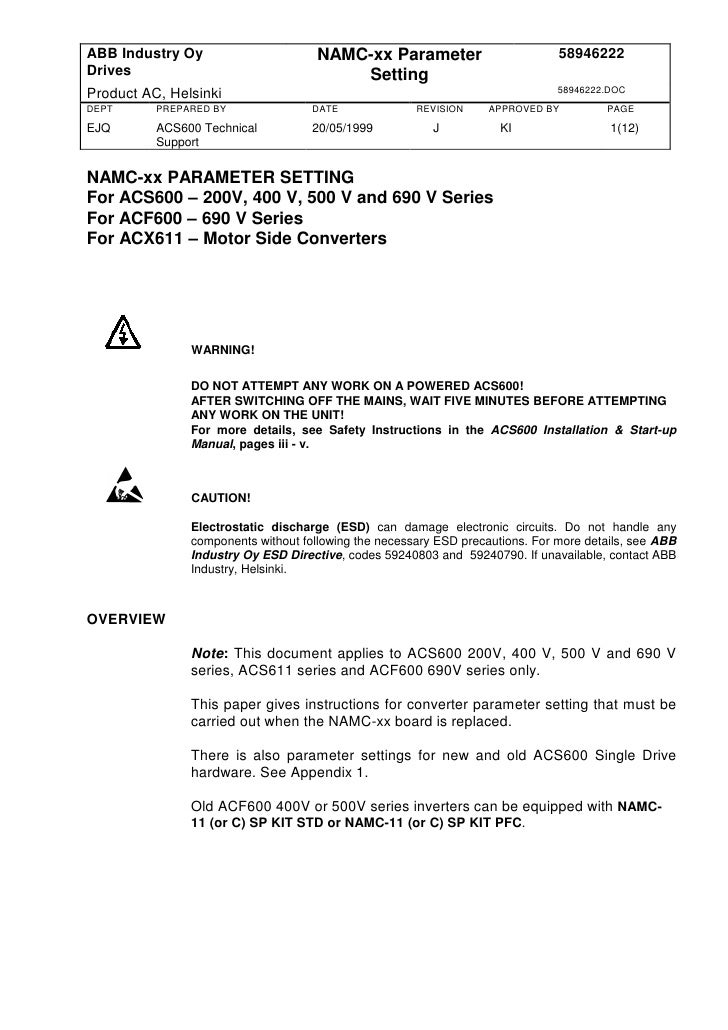- Powerflex 4 Setting Parameters
- Parameter Setting In Evolutionary Algorithms
- Parameter Settings
- Delta Vfd B Parameter Settings
- Parameter Setting Of Injection Moulding Machine
- Parameter Settings Ver2.7
- Parameter Setting Chomsky
Parameter values that are not simple identifiers or numbers must be single-quoted. To embed a single quote in a parameter value, write either two quotes (preferred) or backslash-quote. If the file contains multiple entries for the same parameter, all but the last one are ignored. Parameters set in this way provide default values for the cluster. The NoEcho property is set to true to prevent describe stack calls, such as the aws cloudformation describe-stacks AWS CLI command, from returning the parameter value. The minimum length that can be specified is 1, and the maximum length that can be specified is 41. Execute SQL Task in SSIS allows user to execute parameterized SQL statement and create mapping between these parameters and the SSIS variables. To add a parameter into a SQL statement you must use a parameter marker which differs based on the connection type. Set-LocalGroup: Parameter set cannot be resolved using the specified named parameters. At line:1 char:15 + Set-LocalGroup Set-LocalGroup, ParameterBindingException + FullyQualifiedErrorId: AmbiguousParameterSet,Set-LocalGroup A similar but more.
Powerflex 4 Setting Parameters
The efficiency of a GA is greatly dependent on its tuning parameters.Your choices are to either use one of several 'standard' parameter settingsor to calculate your own settings for your specific problem.
Jump to:
Standard Parameter Settings
There are several recommended settings:
Dejong Settings (From [DeJong and Spears, 1990]):
Dejong's settings are the de facto standard formost GAs. Dejong has shown that this combination of parameters works betterthan many other parameter combinations for function optimization.
- Population size 50
- Number of generations 1,000
- Crossover type= typically two point
- Crossover rate of 0.6
- Mutation types= bit flip
- Mutation rate of 0.001
Notes:
The crossover method is assumed to be one or two point crossover. Formore disruptive methods (such as uniform crossover), use a lower crossoverrate (say 0.50).
The mutation rate given above is *per bit*, whereas in many publicdomain codes, the mutation rate is input as a *per chromosome* probability.Make sure your mutation rates aren't too low!
REFERENCE:
DeJong, K.A. and Spears, W.M. 'An Analysis of the Interacting Rolesof Population Size and Crossover in Genetic Algorithms,' Proc. FirstWorkshop Parallel Problem Solving from Nature, Springer-Verlag, Berlin,1990. pp. 38-47.
Grefenstette Settings (From [Grefenstette,1986]):

This is generally the second most popular setof parameter settings. It is typically used when the computational expenseof figuring the objective function forces you to have a smaller population.
- Population size 30
- Number of generations not specified
- Crossover type= typically two point
- Crossover rate of 0.9
- Mutation types= bit flip
- Mutation rate of 0.01
Notes:
The crossover method is again assumed to be one or two point crossoverand the mutation rate is also *per bit*.

REFERENCE:
Grefenstette, J.J. 'Optimization of Control Parameters for GeneticAlgorithms,' IEEE Trans. Systems, Man, and Cybernetics, Vol. SMC-16,No. 1, Jan./Feb. 1986, pp. 122-128.
MicroGA Settings From DavidL. Carroll
Parameter Setting In Evolutionary Algorithms
These settings are not widely employed currently,but those who have used them to optimize functions report as much as four-foldreductions in the number of evaluations required to reach given levelsof performance.
- Population Size = 5 (see below)
- Number of generations = 100
- Crossover type= uniform
- Crossover probability= 0.5
- Mutation types= jump and creep
- Mutation probabilities= 0.02 and 0.04 (see below)
Notes:
David's code continously restarts with random chromosomes when convergenceis dectected, so these parameters may not work well for other codes.
Rough Comparison

I tried these sets of parameters in Sugal,a nice GA with a GUI interface for MS-Windows. The problem is a Dejongerror function, the goal is to minimize the error. Below is a screen printshowing how quickly each parameter setting found the minimum. I've in noway tried to be exhaustive about this test case, and you should be suspiciousthat Dejong's parameters do best on a Dejong problem. Its simply meantto give you some idea of the relative strengths of the different settings.
Customizing ParameterSettings
Population Size
Some problems have very large solution spaces(i.e. many variables, with a large range of permissible values for thosevariables). In these cases, a population of 100 individuals is probablynot enough because it simply doesn't represent a large enough sample ofthe solution space. The following rules of thumb will help determine howbig a population you will need.
The following crude population scaling law is based on [Goldberg &Deb, 1992] courtesy of DavidL. Carroll
- forbinary coding
where
- length = number of binary bits in each individual
- chromsize = the average size of the schema of interest (effectivelythe average number of bits per chromosome, i.e. length/Number of parametersencoded by one individual), rounded to the nearest integer
David notes that this scaling law is usually overkill, i.e. you canmost likely get by with populations at least twice as small.
Drawing on the statistical calculations of another discpline, SunTzu1@aol.comprovides another possibile method for calculating the population size:
In the field of cluster analysis there is a relationship between thequality of the estimate of the cluster statistics, the number of samplesin the cluster, and the number of parameters defining a cluster member.It may be possible to view each chromosome as a vector and, in order toprevent biases from creeping into the solutions, the population (numberof samples) must increase as the vector size increases. This relationshipis:
- forbinary coding
where
- length = number of binary bits in each individual
- B = a measure of the confidence interval for the statisticalestimate (typically 0.05 or 0.1)
Parameter Settings
Number of Generations
When do you stop a GA? The following observationsare from Jeffrey Horn
In a basic ('simple') GA with selection, crossover, and low(or no) mutation), the population should indeed converge in 'justa few' generations (e.g., 30 to 50 gens with a population of size1000). Goldberg and Deb (1991) indicated that pure selection convergencetimes are O(log N) generations, where N is population size. This is indeedwhat I observe. So GA search is over fairly quickly. This can be turnedinto a strength of the GA by using larger population sizes (Goldberg, Deb,& Clark, 1992) and/or restarting the GA with a new random initial populationupon detection of population convergence (Goldberg, Kargupta, Horn, &Cantu-Paz, 1995).
By encoding some linkage knowledge into the chromosome, 'mixing'of good building blocks can be expected to take place before convergence(given adequate population sizes also) (Thierens & Goldberg, 1993).
So I believe it is important to detect near-uniformity of the populationand terminate the GA, before wasting function evaluations on an inefficient,mutation-based search. Of course, if you maintain useful diversity in yourpopulations using a 'restorative force' to balance convergence,such as a niching method (Horn, 1993; Mahfoud, 1995), then all bets areoff; there is no (practical) convergence to be detected. Apparently, usefulsearch continues during some kind of noisy, but stable and diverse, steadystate.
There are a number of estimates of population convergence. I like the'bit-wise average convergence measure' we used in some of theexperiments in (Goldberg, Kargupta, Horn, & Cantu-Paz, 1995). We measuredthe convergence at each loci (i.e., the percentage of the population witha single allele at that locus) and averaged over all loci. When this averageexceeds some threshold, say 90%, we call it quits. I do not think the performanceof the GA, especially w.r.t solution quality, is much affected by the EXACTmethod/threshold of convergence measure.
REFERENCES:
- Goldberg, and Deb, (1991). A comparative analysis of selection schemesused in GAs. In G. Rawlins (Ed.), Foundations of GAs (FOGA). San Mateo,CA: Morgan Kaufmann, 69--93.
- Goldberg, D.E., Deb, K., & Clark, J.H. (1992). Genetic algorithms,noise, and the sizing of populations. Complex Systems, 6. 333-362.
- Goldberg, D. E., Kargupta, H., Horn, J., & Cantu-Paz, E. (1995).Critical deme size for serial and parallel genetic algorithms. IlliGALReport 95002 (The Illinois GA Lab, University of Illinois). 24 pp.
- Thierens, D., & Goldberg, D.E. (1993). Mixing in genetic algorithms.In S. Forrest (Ed.), Proceedings of the Fifth International Conferenceon Genetic Algorithms (ICGA 5). San Mateo, CA: Morgan Kaufmann, 38-45.
- Horn, J. (1993). Finite Markov chain analysis of genetic algorithmswith niching. In ICGA 5, 110-117.
- Mahfoud, S. W. (1995). Niching methods for genetic algorithms . 251pp. (a dissertation from the University of Illinois). (also IlliGAL ReportNo. 95001)
The above publications are available from IlliGAL by ftp,http, or you canemail a request for hardcopy.
Mutation Probability
InmanHarvey of the Evolutionary and Adaptive Systems Group at the Universityof Sussex, England argues that:
Delta Vfd B Parameter Settings
...for some particular purposes mutation rates should be set at somethingbased on 1 mutation per genotype (which would be applied with independentprob at each locus of 1/LEN). This to be adjusted by a factor related tothe log of the selection pressure, and log(s) is typically of order 1.At the _expected_ rate of 1 per genotype, then roughly 1/e=37% of the timethere are no mutns, 1/e=37% there is 1, 1/e^2=13.5% there are 2, ...
He kindly posted to comp.ai.geneticsome c code for efficiently doing this.
David Beasley (David.Beasley@cs.cf.ac.uk)adds:
Parameter Setting Of Injection Moulding Machine
I agree with all that Inman says. However, Inman seems to be mainlytalking about traditional 'bitwise' ('genewise'?) mutation, where, on agene-by-gene basis, a decision is taken whether to mutate the gene or not.
But lots of GAs dont use genewise mutation - they use other types ofmutation operators, which operate on _groups_ of genes. Unfortunately,there is little in the literature about how to set suitable 'mutationrates' in these cases. This is, I guess, partly because the optimumis highly problem dependent.
However, I would venture the following opinion (which I have basedmy own research upon). Following the principles of genewise mutation, whichInman has poined out, there should be roughly a 30-40% chance of no mutation,roughly a 30-40% chance of a very small amount of mutation, and a smallerchance of a slightly larger amount of mutation.
So, if a mutation operator is used which works on a whole section ofa chromosome (not just a single gene), then it should be operated on thelines suggested above. This means not simply adjusting a single 'mutationrate' parameter, but also designing the operator itself so that, usually,only a small amount of the chromosome is affected.
For example, if the mutation operator scrambles all the genes in asub-string, it should be designed so that the length of the sub-stringis usually short. On top of that, you want an overall 'mutation rate'parameter, which sees that there is no mutation at all for about 30-40%of chromosomes.
Parameter Settings Ver2.7

Parameter Setting Chomsky

